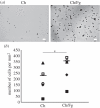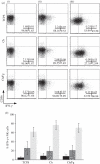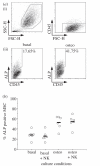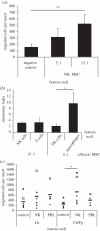Enhanced mesenchymal stromal cell recruitment via natural killer cells by incorporation of inflammatory signals in biomaterials
- PMID: 21752807
- PMCID: PMC3243397
- DOI: 10.1098/rsif.2011.0357
Enhanced mesenchymal stromal cell recruitment via natural killer cells by incorporation of inflammatory signals in biomaterials
Abstract
An exacerbated inflammatory response questions biomaterial biocompatibility, but on the other hand, inflammation has a central role in the regulation of tissue regeneration. Therefore, it may be argued that an 'ideal' inflammatory response is crucial to achieve efficient tissue repair/regeneration. Natural killer (NK) cells, being one of the first populations arriving at an injury site, can have an important role in regulating bone repair/regeneration, particularly through interactions with mesenchymal stem/stromal cells (MSCs). Here, we studied how biomaterials designed to incorporate inflammatory signals affected NK cell behaviour and NK cell-MSC interactions. Adsorption of the pro-inflammatory molecule fibrinogen (Fg) to chitosan films led to a 1.5-fold increase in adhesion of peripheral blood human NK cells, without an increase in cytokine secretion. Most importantly, it was found that NK cells are capable of stimulating a threefold increase in human bone marrow MSC invasion, a key event taking place in tissue repair, but did not affect the expression of the differentiation marker alkaline phosphatase (ALP). Of significant importance, this NK cell-mediated MSC recruitment was modulated by Fg adsorption. Designing novel biomaterials leading to rational modulation of the inflammatory response is proposed as an alternative to current bone regeneration strategies.
Figures





References
-
- Mountziaris P. M., Mikos A. G. 2008. Modulation of the inflammatory response for enhanced bone tissue regeneration. Tissue Eng. Part B Rev. 14, 179–18610.1089/ten.teb.2008.0038 (doi:10.1089/ten.teb.2008.0038) - DOI - DOI - PMC - PubMed
-
- Anderson J. M., Rodriguez A., Chang D. T. 2008. Foreign body reaction to biomaterials. Semin. Immunol. 20, 86–10010.1016/j.smim.2007.11.004 (doi:10.1016/j.smim.2007.11.004) - DOI - DOI - PMC - PubMed
-
- Agaiby A. D., Dyson M. 1999. Immuno-inflammatory cell dynamics during cutaneous wound healing. J. Anat. 195, 531–54210.1046/j.1469-7580.1999.19540531.x (doi:10.1046/j.1469-7580.1999.19540531.x) - DOI - DOI - PMC - PubMed
-
- Vivier E., Tomasello E., Baratin M., Walzer T., Ugolini S. 2008. Functions of natural killer cells. Nat. Immunol. 9, 503–51010.1038/ni1582 (doi:10.1038/ni1582) - DOI - DOI - PubMed
-
- Aggarwal S., Pittenger M. F. 2005. Human mesenchymal stem cells modulate allogeneic immune cell responses. Blood 105, 1815–182210.1182/blood-2004-04-1559 (doi:10.1182/blood-2004-04-1559) - DOI - DOI - PubMed
Publication types
MeSH terms
Substances
LinkOut - more resources
Full Text Sources

